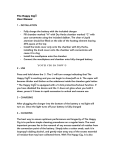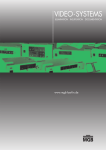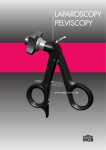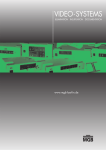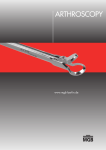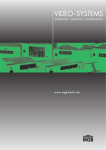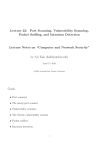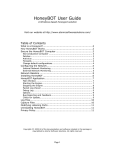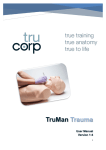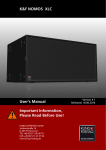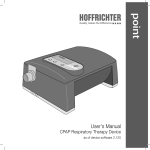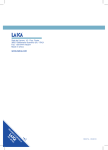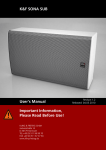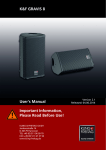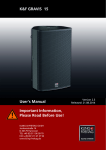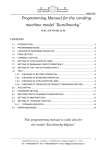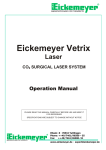Download Telescope - Frimed Medizintechnik GmbH
Transcript
EN Abb. 1: FRIMED Telescope Pos. 1 2 3 4 5 6 Description Eyepiece Eyepiece window Distal window Light cable connector Shaft lock (optional) Telescope shaft Abb. 2: Light cable adaptors for FRIMED - Telescopes FRIMED Telescope Instructions for use This user manual should help to use, clean and sterilize FRIMED telescopes properly. It must not be used as an instruction for medical inspection or surgical operations. The Telescope is labeled with its product no. (e.g. 034-700-050), the FRIMED trademark, its direction of view (e.g. 0°) and its serial no. (e.g.12345). The working length and the diameter of the telescope shaft are labeled on the telescope packaging. 1. Intended use Telescopes are applied for visualization of the surgical site in the cause of diagnostic and therapeutic surgical operations. They are inserted into the human body through natural or artificially created orifices. Each telescope has a certain field of application. To classify the different fields of application each telescope has a certain product number. They are listed below. Field of Application Sinoscopy Laryngoscopy Otoscopy FRIMED Product No Visualization of nasal & paranasal cavities Visualization of the larynx Visualization of the outer ear 034-70X-XXX 2. User qualification The usage of endoscopic instruments is only allowed by a doctor or medical staff under supervision of a doctor. The user needs to be trained sufficiently in the field of clinical practice. 3. General safety notes Warning! FRIMED telescopes are delivered non-sterile and have to be cleaned, disinfected and sterilized before first usage and before all following usages. Rigid endoscopes may not be bent, twisted pulled or pressed. This can damage the telescope and make it useless for future operations. The distal tip and the light cable connector can heat up to over 41 °C when using high performance light cables. For this reason contact with those parts may lead into tissue or material damages. Please avoid longsome usage of intense light. Please keep optical surfaces clean. Please do not touch the distal end. Please pay attention that there is no contact between hot parts and flammable liquids. Ignition hazard! Before using telescopes with shaft lock, please check that the telescope locks into the shaft properly. 4. Function control Upon receipt as well as before any usage please check the telescope carefully for damages. If there are obvious damages or adverse optical effects the telescope may not be used anymore. In this case please contact the local representative or directly the FRIMED service department. Outer condition - The product may not show any signs of damages (e. g. dents, cracks, drags) - The product may not show any contaminations or residua of cleaning or disinfection solutions. - Please ensure that no parts are missing or loose (eyepiece, light cable connectors). Warning! Contacting a rotating shaver or other cutting instruments can cause sharp or jagged edges on telescope. Parts of telescope could break inside of patient. Dateiname mit Revisionsstand: Bedienungsanleitung_Optikenen_en_Rev_2.1_FRIMED.doc erstellt von: jw erstellt am: 04.11.14 geändert von: - geändert am: - Seite 1 von 4 Image quality - The telescope has three optical surfaces: the distal tip (windows and light cable exit), the eyepiece window and the light cable connector. The image quality is very depending on the condition of these surfaces. - Check the optical surfaces at the ends (distal tip and eyepiece window) for scratches and remains of detergent. The surface should be smooth and shiny. - To test the image quality, rotate the telescope slowly while seeing through it. If the image is completely or partially impaired, the lens system inside the cladding tube is broken. - Check the light guide connector. Keep the distal end into the direction of a light source and check the quantity of dark spots on light guide connector. These dark spots indicate broken light fibers. A few broken light fibers do not mean any major impairment. If the quantity exceeds the 20% level the light intensity and thus the image quality will considerably worsen. In such a case the telescope should not be used anymore. In case of adverse optical effects the telescope may not be used anymore! 5. Light cable connector adaptors The adapters as included in delivery can be used with almost all common light cables. In order to connect the light guide with the telescope, screw the respective adapter (refer to Fig. 2) onto the telescope. 6. Restrictions for reprocessing Frequently reconditioning hardly affects the quality of telescopes. The end of the product lifetime is normally defined by the wear and damage by use. 7. Reprocessing of telescopes 7.1 Cleaning preparation It is recommended to reprocess the telescopes after usage as soon as possible. Therefor all adapters must be removed from the light guide connector. Use separate boxes for telescopes and instruments. 7.2. Manual cleaning Raw dirt: After usage the telescope must be carefully and accurately cleaned. Raw dirt must be removed with much water. Optical surfaces: Optical surfaces must be cleaned with a 70% ethanol impregnated dabber. Do not use a brush. Warning! Ultrasonic cleaning is not permitted for telescopes Mild detergent solution: The real cleaning must be done with clothes and soft brushes and a mild detergent solution. 7.3. Flush with distilled water After cleaning flush the telescopes with deionized water to prevent the formation of deposits. Deposits can be removed with wadding. Warning! Never use metal objects on scopes! If the cleaning has not been successful, please repeat above steps. 7.4. Drying Dry the telescopes with a soft cloth or use medical clean compressed-air. If necessary mount removed adapters on the light guide connector. Dateiname mit Revisionsstand: Bedienungsanleitung_Optikenen_en_Rev_2.1_FRIMED.doc erstellt von: jw erstellt am: 04.11.14 geändert von: - geändert am: - Seite 2 von 4 7.5. Disinfection Only accurately mechanically pre-cleaned telescopes may be disinfected. We recommend disinfectants on aldehyde or alcohol basis. Pay attention to the immersion time and mixing ratio specified by the manufacturer! Exceeding the immersion time can cause damage to the telescopes! Due to corrosion protection the immersion time of telescopes in fluids, including sterile water, must not exceed 60 minutes. Attention! The entire telescope has to be covered with disinfectant. There must not be any air bubbles on the telescope surface. After disinfecting the telescopes, the disinfectant must be removed completely. For flushing use deionized water under sterile conditions. Dry telescopes with sterile clothes and dabber and wrap it in a sterile cloth afterwards. 7.6. Sterilization Steam sterilization FRIMED telescopes can be sterilized with steam up to 134°C without hesitation. Fractionated prevacuumed procedures should be used. Pack the dry telescopes after cleaning and disinfection into special Endoscope sterilization container or sterilization foil. If telescopes are not cleaned accurately before autoclaving, particles and dirt can harden on the surface due to sterilization and can only hardly be removed. Owing to that, lifetime and optical quality of the scopes can be affected. The conditions for steam sterilization are specified as follows: Temperature: Pressure: Residence time: Charge time: 134 °C 2.2 bar 5 – max. 7.5 min. 20 - 30 min Attention! While steam sterilization the telescopes may not get in direct contact with metal objects (e.g. sterilization container, metal instruments). Attention! Remove telescopes after autoclaving only when they already cooled down to room temperature. Warning! Do not use „Flash“ autoclaving for telescopes. 8. Other reprocessing and sterilization procedures Other reprocessing and sterilization procedures not mentioned in this manual, may not be used or only in prior consultation with the manufacturer. 9. Storage Telescopes should always be stored in suitable boxes (e.g. sterilization boxes with telescope holder) and have to be protected against mechanical load. The storage of the telescopes has to be under normal temperature and humidity conditions (10 to 50 °C, 20 to 80 % r. h.). - For temporary storage telescopes must be stored sterile and ready to use. - For long-term storage keep telescopes clean and ready to sterilize. If telescope is provided with a protection sleeve on the distal end, it should be used for long-term storage. Dateiname mit Revisionsstand: Bedienungsanleitung_Optikenen_en_Rev_2.1_FRIMED.doc erstellt von: jw erstellt am: 04.11.14 geändert von: - geändert am: - Seite 3 von 4 10. Practical shelf life of sterilized instruments The practical storage life of sterilized instruments depends on the type of packaging, storage conditions and the local rules (see DIN 58953). 11. Service The high quality and performance as well as safety and reliability of FRIMED telescopes can only be guaranteed if resettings, changes or repairs of this product are made by the manufacture FRIMED themselves and the use of this telescope is in accordance to the instruction manual. FRIMED does not supply original components to any independent service stations or manufacturers. Therefore only FRIMED is able to repair it’s own telescopes with original components to guarantee the original performance specifications and safety. The warranty for FRIMED telescopes expires if repairs are not done by FRIMED or reprocessing methods are applied which are not recommended by FRIMED. Please contact your sales representative, distributor or FRIMED service for product service and specific warranty information. Telefon: ..........................+49 7461 96618-42 Telefax: ..........................+49 7461 96618-50 E-Mail: [email protected] In case of shipment of a defect telescope please use the original packaging. If this is impossible please pay attention that each telescope is carefully packed and protected. FRIMED is not liable for any damages which are due to insufficient packaging. Attention! For protection the service staff the telescope has to be cleaned, disinfected and sterilized before sending in. 12. Manufacturer contact Frimed Medizintechnik GmbH Junkersstr. 1 D-78532 Tuttlingen / Germany Tel: +49 7461 /96618-42 FAX: +49 07461 /96618-50 E-Mail: [email protected] Internet: http://www.frimed.de The listed instructions were validated by FRIMED to prepare and reprocess a medical device. The user is responsible for ensuring that the reprocessing with the used equipment, materials and staff provides the desired results. This requires validation and routine observation of the reprocessing procedure. Each deviation of the provided instruction should be evaluated to effectiveness or possible adverse consequences. Attend also national guidelines, recommendations of German Robert Koch Institute and “Proper Maintenance of Instruments” from Instrument Preparation Working Group www.a-k-i.org. Specifications may change without prior notice. Dateiname mit Revisionsstand: Bedienungsanleitung_Optikenen_en_Rev_2.1_FRIMED.doc erstellt von: jw erstellt am: 04.11.14 geändert von: - geändert am: - Seite 4 von 4





